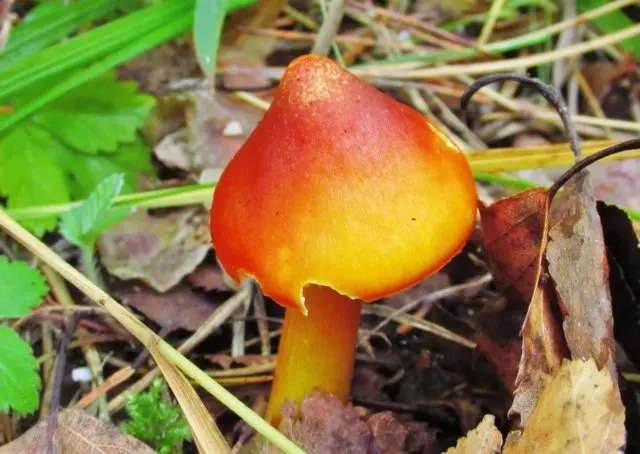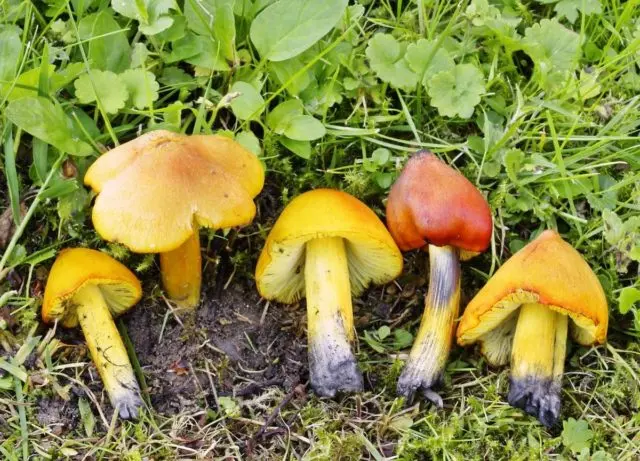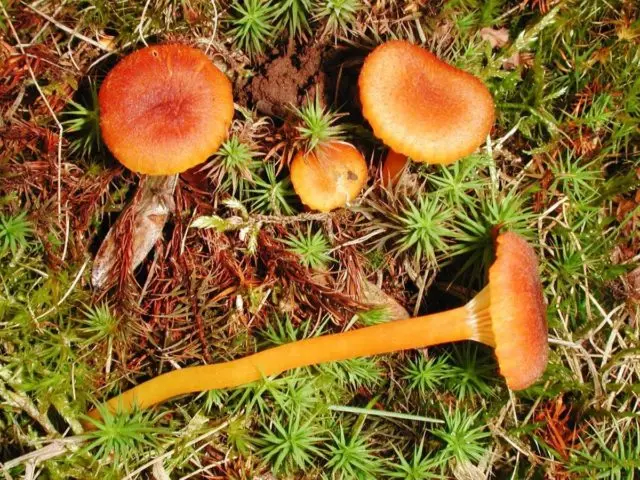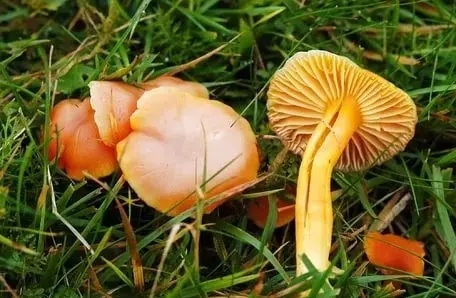Contents
Hygrocybe conical (Hygrocybe conica) is not such a rare mushroom. Many saw him, even knocked him down with their feet. Mushroom pickers often call it a wet head. Belongs to agaric mushrooms from the Hygroforaceae family.

What does a conical hygrocybe look like
A description is necessary, because novice mushroom pickers often take all the fruiting bodies that come to hand, without thinking about their benefits or harms.
Hygrocybe conical has a small hat. The diameter, depending on age, can be 2-9 cm. In young mushrooms, it is in the form of a pointed cone, bell or hemispherical. In mature wetheads, it becomes broadly conical, but a tubercle remains on the very top of the head. The older the conical hygrocybe, the more tears on the cap, and the plates are clearly visible.
During rains, the surface of the crown becomes glossy and sticky. In dry weather, it is silky and shiny. In the forest there are mushrooms with red-yellow and red-orange caps, and the tubercle is somewhat brighter than the entire surface.

The legs are long, even, straightened, fine-fibered and hollow. At the very bottom they have a slight thickening. In color, they are almost the same as the caps, but the base is whitish. There is no mucus on the legs.
On some specimens, the plates are attached to the cap, but there are conical hygrocybes, in which this part is free. In the very center, the plates are narrow, but widen at the edges. The lower part of the yellowish color. The older the fungus, the grayer this surface. When touched or pressed, it becomes grayish-yellow.
Differ in thin and very fragile pulp. In color, it does not stand out from the fruiting body itself. Turns black when pressed. The pulp does not stand out with taste and aroma, they are inexpressive.
Ellipsoid white spores. They are very small – 8-10 by 5-5,6 microns, smooth. Hyphae have buckles.
Where does hygrocybe conical grow
Vlazhnogolovka prefers young plantings of birches, aspens. Likes to breed in moorlands and along roadsides. Where there is a lot of grass cover:
- along the very edge of deciduous forests;
- on the edges, meadows, pastures.
In pine forests, you can see single specimens.
The fruiting of the wet head is long. The first mushrooms are found already in May, and the latest ones grow until frost.
Is it possible to eat hygrocybe conical
Despite the fact that Hygrocybe conicalis is slightly poisonous, it should not be collected. The fact is that it can cause serious problems with the intestines.
Relatives of hygrocybe conical
Other types of hygrocibe should also be distinguished, which are very similar to the conical:
- About Hygrocibe or lint. In young specimens, the hat is convex, then a recess appears in it. On a dry surface, scales are clearly visible. In the center it is bright red, at the edges it is much lighter, almost yellow. The leg is cylindrical thin, with a slight curvature. There is a whitish coating on the base. Fragile whitish flesh is inedible. Fruiting continues from May to October. Refers to inedible.

- Oak hygrocibe is very similar to a wet head. Young mushrooms have a conical cap with a diameter of 3-5 cm, which then levels off. She is yellow-orange. When the weather is wet, mucus appears on the hat. The plates are rare, of the same shade. The taste and aroma of yellowish flesh is inexpressive. Yellow-orange legs up to 6 cm long, very thin hollow, slightly curved.
- Hygrocybe oak unlike its relatives, it is conditionally edible. It is found in mixed forests, but bears fruit best under oaks.

- Hygrocybe acute conical or preserved. The shape of the yellow or yellow-orange cap varies with age. At first it is conical, then it becomes wide, but the tubercle still remains. There are fibers on the mucous surface of the cap. The pulp is practically odorless and tasteless. The legs are very high – up to 12 cm, diameter – about 1 cm.Important! The inedible mushroom is found in meadows, pastures, and forests from summer to autumn.

Conclusion
Hygrocybe conical – inedible slightly poisonous mushroom. It can cause problems with the gastrointestinal tract, so it is not eaten. But being in the forest, one should not knock down the fruiting bodies with their feet, since there is nothing useless in nature. As a rule, inedible and overgrown forest products are food for wild animals.












